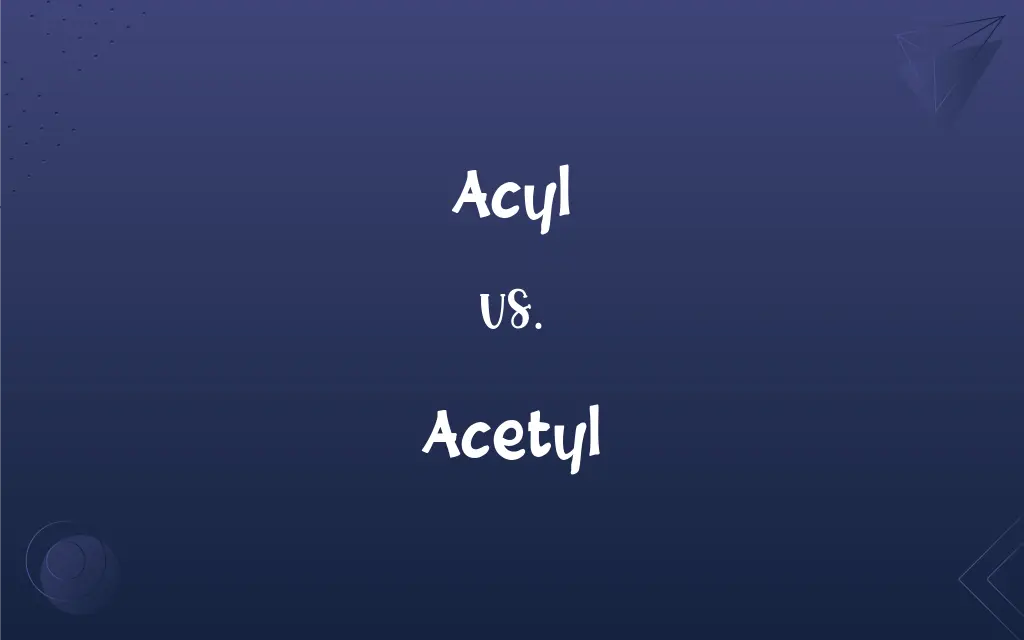Acyl vs. Acetyl: What's the Difference?
Edited by Aimie Carlson || By Harlon Moss || Updated on October 24, 2023
Acyl is a functional group derived from carboxylic acids, while acetyl specifically refers to the two-carbon acyl group derived from acetic acid.

Key Differences
Acyl, in organic chemistry, represents a functional group derived from carboxylic acids where a hydroxyl group has been replaced by another group, often an alkyl. It encompasses a broad range of compounds. Acetyl, on the other hand, is a specific type of acyl group. It is the two-carbon acyl group derived from acetic acid, possessing the chemical formula CH₃CO.
Both acyl and acetyl play significant roles in biochemistry and organic synthesis. While acyl can be seen as a general descriptor for a class of organic compounds with a CO group, acetyl is a specific member of this class. The distinction is similar to that between a general category and a specific item within that category.
The acyl group's general structure can be represented as RCO-, where "R" can be any alkyl or aryl group. Acetyl, being a subtype, always has a methyl group attached, represented as CH₃CO-. In terms of reactivity, acyl groups can be involved in various reactions, but the reactions specific to acetyl groups might be limited due to its fixed structure.
In biological systems, acyl groups are often involved in the formation of esters and amides, crucial for many cellular processes. Acetyl, as a specific acyl derivative, is vital for processes like acetylation, where an acetyl group is added to a molecule, modifying its function.
Comparison Chart
Definition
A functional group derived from carboxylic acids
A two-carbon acyl group from acetic acid
ADVERTISEMENT
General Formula
RCO-
CH₃CO-
Scope
Broad category
Specific type within acyl
Occurrence
Found in various compounds
Found in specific compounds like acetic acid
Biochemical Role
In esters and amides
In processes like acetylation
Acyl and Acetyl Definitions
Acyl
Acyl is an organic functional group derived from carboxylic acids.
The acyl group plays a crucial role in lipid molecules.
ADVERTISEMENT
Acetyl
Acetyl is the acyl group derived from acetic acid.
Acetyl coenzyme A is a central molecule in metabolism.
Acyl
Acyl derivatives are common in biochemistry and organic synthesis.
Enzymes that transfer acyl groups are essential in metabolism.
Acetyl
Acetyl has the chemical formula CH₃CO-.
The acetyl group was attached to the lysine residue of the protein.
Acyl
Acyl represents compounds where a carboxylic acid's hydroxyl group is replaced.
Acyl chlorides are reactive derivatives of carboxylic acids.
Acetyl
Acetyl groups are involved in reactions like acetylation.
The protein's function changed upon acetyl addition.
Acyl
Acyl groups are typically represented by the formula RCO-.
The reaction involved the transfer of an acyl group to the substrate.
Acetyl
Acetyl compounds often have distinctive smells.
Acetyl derivatives are used in the fragrance industry.
Acyl
Acyl can be attached to other molecules forming esters or amides.
Glycerides contain acyl groups attached to a glycerol backbone.
Acetyl
Acetyl is a specific two-carbon acyl group.
Acetyl groups play a role in the regulation of gene expression.
Acyl
An organic group having the general formula RCO-, derived from an organic acid.
Acetyl
The methyl acyl group, CH3CO, formally derived from acetic acid.
Acyl
(organic chemistry) Any of class of organic radicals, RCO-, formed by the removal of a hydroxyl group from a carboxylic acid.
Acetyl
(organic chemistry) The univalent radical CH3CO- derived from acetic acid.
Acyl
An acid radical, as acetyl, malonyl, or benzoyl. An acyl radical can be depicted as R-CO-, where -CO- is the carbonyl group, and R is the group that characterizes the acyl moiety.
Acetyl
A complex, hypothetical radical, composed of two parts of carbon to three of hydrogen and one of oxygen. Its hydroxide is acetic acid.
Acyl
Any group or radical of the form RCO- where R is an organic group;
An example of the acyl group is the acetyl group
Acetyl
The organic group of acetic acid (CH3CO-)
FAQs
What are acyl chlorides?
Acyl chlorides are derivatives of carboxylic acids where the hydroxyl group is replaced by a chlorine atom.
What is the general formula for acyl compounds?
RCOX, where R is an alkyl or aryl group, and X represents the remaining part of the compound, often a halogen or OR' group.
What is an acyl group?
An acyl group is a functional group derived from carboxylic acids, represented as RCO-, where R is an alkyl group.
How are acyl groups used in organic chemistry?
They're involved in various reactions, notably in the formation of esters and amides.
How is an acyl group formed?
It's formed by removing a hydroxyl group (OH) from a carboxylic acid.
What does acylation mean?
Acylation is the process of adding an acyl group to a molecule.
Are acyl groups polar?
Yes, due to the carbonyl group (C=O) which imparts polarity.
Is acyl a stable group?
Acyl compounds can be reactive, especially acyl chlorides and anhydrides, which react with water and alcohols.
What is an acetyl group?
An acetyl group is a type of acyl group with the formula CH3CO-.
What's the difference between acyl and acetyl?
While acyl is a general term for RCO-, acetyl specifically refers to the CH3CO- group.
How is acetylcholine related to the acetyl group?
Acetylcholine is a neurotransmitter containing an acetyl group attached to choline.
Is acetylsalicylic acid related to the acetyl group?
Yes, acetylsalicylic acid (aspirin) contains an acetyl group and is derived from salicylic acid.
What does the "aceto-" prefix mean?
It indicates the presence of an acetyl group in a compound.
How does acetylation affect proteins?
Acetylation of proteins, especially at lysine residues, can alter their function, localization, or interaction with other proteins.
Are acetyl groups found in DNA modification?
No, DNA is typically methylated. Acetylation commonly affects histones, which in turn affects DNA expression.
Is an acyl group electron-withdrawing or electron-donating?
It's electron-withdrawing, particularly because of the carbonyl group's influence.
Why is acetyl-CoA important in biology?
Acetyl-CoA is a key molecule in metabolism, connecting glycolysis and the citric acid cycle.
Do acyl groups appear in biological molecules?
Yes, they're seen in molecules like acyl-CoA, vital for lipid metabolism.
What is acetylation?
Acetylation is the process of introducing an acetyl group into a molecule, often involving enzymes in biological systems.
How does acetone relate to the acetyl group?
Acetone (propanone) is the simplest ketone and can be considered a dimethyl derivative of the acetyl group, but it doesn't contain an acetyl group per se.
About Author
Written by
Harlon MossHarlon is a seasoned quality moderator and accomplished content writer for Difference Wiki. An alumnus of the prestigious University of California, he earned his degree in Computer Science. Leveraging his academic background, Harlon brings a meticulous and informed perspective to his work, ensuring content accuracy and excellence.
Edited by
Aimie CarlsonAimie Carlson, holding a master's degree in English literature, is a fervent English language enthusiast. She lends her writing talents to Difference Wiki, a prominent website that specializes in comparisons, offering readers insightful analyses that both captivate and inform.































































